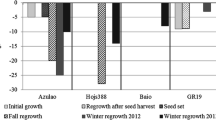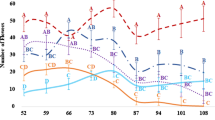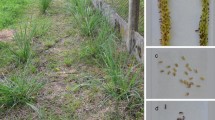Summary
F1 hybrids between short-day photoperiod- sensitive ‘maiwa’ bulrush millet, Pennisetum americanum (2n=14), and elephant grass, P. purpureum (2n=28), are triploid (2n=21), sterile, and can only be propagated vegetatively. Fertile amphidiploids, (2n=42, with 21 bivalents) were produced by colchicine treatment. Good seed set was obtained upon selfing the amphidiploids and the progeny exhibited variable pollen fertility and bivalent univalent and multivalent formation.
Reciprocal crosses between elephant grass and the colchicine-induced amphidiploid failed to produce seeds. The ‘maiwa’ millet x amphidiploid cross resulted in poor seed set and the reciprocal failed. ‘Maiwa’ x amphidiploid hybrids were pollen sterile with 2n=21, rather than the expected 2n=28, indicating chromosome elimination.
Morphologically, the amphidiploids and ‘maiwa’ x amphidiploid hybrids closely resembled elephant grass and the F1 hybrid. The amphidiploids showed no superiority over the F1 hybrid and elephant grass in either forage yield or quality but one ‘maiwa’ x amphidiploid genotype surpassed a promising local elephant grass selection in forage dry matter yield and flowered for a relatively short period.
Similar content being viewed by others
References
AOAC, 1970. Official methods of analysis of the Association of Official Analytical Chemists (11th ed.) Association of Official Analytical Chemists, Washington, D.C.
Asay, K. R. & D. R. Dewey, 1976. Fertility of 17 colchicine-induced perennial Triticeae amphiploids through four generations. Crop Sci. 16: 508–513.
Buckner, R. C., H. D. Hill, A. V. Hovin & P. B. Burrusii, 1965. Fertility of annual ryegrass x tall fescue amphidiploids and their derivatives. Crop Sci. 5: 395–397.
Chheda, H. R., M. E. Aken'ova & L. V. Crowder, 1973. Pennisetum typhoides S & H x P. purpureum Schum, hybrids for forage in the low-altitude humid tropics. Crop Sci. 13: 122–123.
Gildenhuys, P. & K. Brix, 1961. Genic control of aneuploidy in Pennisetum. Heredity 16: 358–363.
Gildenhuys, P. & K. Brix, 1964. Genically controlled variability of chromosome number in Pennisetum hybrids. Heredity 19: 533–542.
Gildenhuys, P. & K. Brix, 1965. The relationship between embryo and endosperm in interspecific hybrids in Pennisetum. Ann. Bot. (London) 29: 709–715.
Gildenhuys, P. & K. Brix, 1969. Selective elimination of unbalanced gametes and zygotes in an interspecific hybrid of Pennisetum and its backcross derivatives. Agroplantae 1: 77–83.
Horn, D. L. van & M. Takahashi, 1948. Cattail millet x Napier grass hybrids. In: Report of the University of Hawaii Agric. Expt. Sta. for the biennium ending June 30, 1948. 171 pp.
Jauhar, P. P., 1968. Inter-and intra-gemomal chromosome pairing in an interspecific hybrid and its bearing on basic chromosome number in Pennisetum. Genetics 39: 360–370.
Krishnaswamy, N. 1962. Bajra. Pennisetum typhoides S & H. India Council Agric. Res. New Delhi. Cereal Crop Ser. No. 11. 94 pp.
Krishnaswamy, N. & V. S. Raman, 1951. Cytogenetical studies in the interspecific hybrid of Pennisetum typhoides x P. purpureum. Proc. 1st Sci. Workers Conf. Dept. Agric Madras pp. 43–71. Supdt. Govt. Press Madras.
Krishnaswamy, N. & V. S. Raman, 1954a. A preliminary note on two chromosome deficient plants in Pennisetum purpureum Schum. and their genetic significance. Genetica 27: 1–16.
Krishnaswamy, N. & V. S. Raman, 1954b. Studies on the interspecific hybrid of Pennisetum typhoides Stapf and Hubb. x P. purpureum Schumach. III. The cytogenetics of the colchicine-induced amphidiploid. Genetica 27: 253–272.
Krishnawamy, N. & V. S. Raman, 1956. Studies on the interspecific hybrid of Pennisetum typhoides x P. purpureum. IV. The cytogenetics of the allotetraploids. Genetica 28: 345–360.
Ramulu, K. S., 1968. Meiosis and fertility in derivatives of amphidiploid Pennisetum. Caryologia 21: 147–156.
Stebbins, G. L., 1952. Species hybrids in grasses. Proc. 6th Int. Grassl. Congr. 1: 247–253.
Stebbins, G. L., 1956. Artificial polyploids as a tool in plant breeding. In: Genetics in plant breeding. Brookhaven Symp. Biol. 9: 37–52.
Author information
Authors and Affiliations
Rights and permissions
About this article
Cite this article
Aken'ova, M.E., Chheda, H.R. Morphology, cytology and forage potential of Pennisetum americanum (L.) K. Schum. x P. Purpureum Schum. amphidiploids. Euphytica 30, 397–404 (1981). https://doi.org/10.1007/BF00034003
Received:
Issue Date:
DOI: https://doi.org/10.1007/BF00034003




